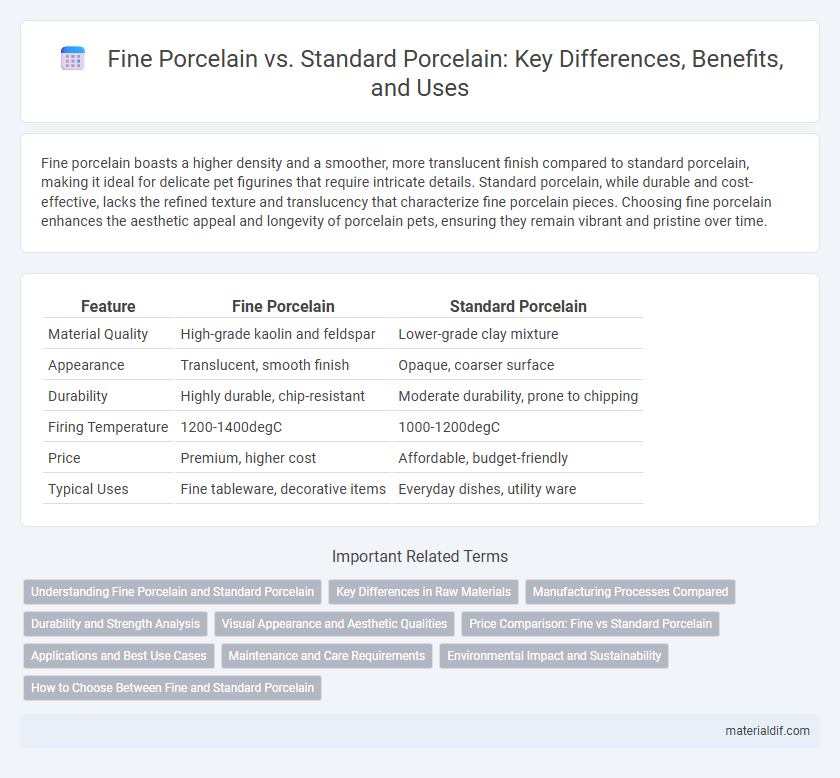Fine porcelain boasts a higher density and a smoother, more translucent finish compared to standard porcelain, making it ideal for delicate pet figurines that require intricate details. Standard porcelain, while durable and cost-effective, lacks the refined texture and translucency that characterize fine porcelain pieces. Choosing fine porcelain enhances the aesthetic appeal and longevity of porcelain pets, ensuring they remain vibrant and pristine over time.
Table of Comparison
| Feature | Fine Porcelain | Standard Porcelain |
|---|---|---|
| Material Quality | High-grade kaolin and feldspar | Lower-grade clay mixture |
| Appearance | Translucent, smooth finish | Opaque, coarser surface |
| Durability | Highly durable, chip-resistant | Moderate durability, prone to chipping |
| Firing Temperature | 1200-1400degC | 1000-1200degC |
| Price | Premium, higher cost | Affordable, budget-friendly |
| Typical Uses | Fine tableware, decorative items | Everyday dishes, utility ware |
Understanding Fine Porcelain and Standard Porcelain
Fine porcelain, also known as bone china, contains a higher percentage of kaolin and bone ash, resulting in a thinner, more translucent, and stronger material compared to standard porcelain. Standard porcelain is made from a mixture of kaolin, feldspar, and quartz, producing a denser, more opaque, and less delicate ceramic often used for everyday tableware. Understanding the composition and firing process of both types helps distinguish fine porcelain's elegance and durability from the practicality and robustness of standard porcelain.
Key Differences in Raw Materials
Fine porcelain is crafted from refined kaolin, feldspar, and quartz, producing a denser, more translucent material with superior whiteness and strength compared to standard porcelain. Standard porcelain typically incorporates less refined clay and a higher proportion of flux materials, resulting in a slightly coarser texture and lower translucency. The purity and particle size of raw materials directly influence the vitrification temperature and final durability of the porcelain product.
Manufacturing Processes Compared
Fine porcelain is manufactured using a higher percentage of kaolin clay, resulting in a smoother texture and increased translucency compared to standard porcelain, which contains more feldspar and quartz for durability. The firing temperature for fine porcelain typically exceeds 1,200degC, allowing for a denser, more vitrified structure, whereas standard porcelain is fired at slightly lower temperatures. These manufacturing differences influence the final product's strength, weight, and aesthetic qualities, making fine porcelain more delicate and refined.
Durability and Strength Analysis
Fine porcelain exhibits superior durability and strength compared to standard porcelain due to its higher density and lower porosity, resulting from a refined clay composition and advanced firing techniques. The enhanced vitrification process in fine porcelain contributes to increased resistance to chipping, cracking, and thermal shock. Standard porcelain, while still robust, generally has a coarser texture and higher porosity, making it more susceptible to wear and damage over time.
Visual Appearance and Aesthetic Qualities
Fine porcelain exhibits a translucent, delicate appearance with a smooth, glass-like surface that enhances its aesthetic appeal, making it ideal for intricate designs and elegant table settings. Standard porcelain tends to be thicker and less translucent, showing a more opaque finish with a slightly rougher texture that emphasizes durability over visual refinement. The clarity and brightness of fine porcelain create a luxurious, refined look, while standard porcelain offers practical beauty with a more robust, everyday charm.
Price Comparison: Fine vs Standard Porcelain
Fine porcelain commands higher prices due to its superior translucency, finer grain, and increased durability compared to standard porcelain. Standard porcelain, while more affordable, offers reliable strength but lacks the delicate texture and refined finish found in fine porcelain. Price differences typically reflect production quality, raw material purity, and manufacturing techniques unique to fine porcelain.
Applications and Best Use Cases
Fine porcelain, characterized by its refined texture, translucency, and high firing temperature, is ideal for luxury tableware, intricate decorative items, and high-end collectibles due to its durability and elegant finish. Standard porcelain, with a denser structure and less refined appearance, is commonly used for everyday dinnerware, cookware, and industrial applications where cost-effectiveness and strength are prioritized. Fine porcelain excels in settings requiring aesthetic appeal and delicate craftsmanship, while standard porcelain is best suited for practical, heavy-use environments.
Maintenance and Care Requirements
Fine porcelain requires delicate handling and gentle cleaning with mild detergents to preserve its translucency and intricate glazes, while standard porcelain is more durable and can withstand regular dishwashing and less careful maintenance. Avoiding abrasive materials and sudden temperature changes is critical for fine porcelain to prevent cracks and surface damage, whereas standard porcelain tolerates more rigorous use and easier cleaning methods. Proper storage and maintenance significantly extend the lifespan of fine porcelain, making it ideal for collectible or special occasion pieces, while standard porcelain suits everyday functional use.
Environmental Impact and Sustainability
Fine porcelain, known for its high-quality kaolin clay and refined firing techniques, generally requires more energy-intensive processes, increasing its environmental footprint compared to standard porcelain. Standard porcelain, produced with less refined materials and lower firing temperatures, tends to consume fewer resources and generate less waste, contributing to better sustainability. Opting for manufacturers prioritizing eco-friendly sourcing and efficient production methods significantly reduces the environmental impact of both fine and standard porcelain products.
How to Choose Between Fine and Standard Porcelain
Choosing between fine porcelain and standard porcelain depends on the desired level of craftsmanship, durability, and aesthetic appeal. Fine porcelain, known for its translucency, delicate texture, and higher firing temperature, offers superior elegance and strength, making it ideal for luxury tableware and artistic pieces. Standard porcelain, while more affordable and durable for everyday use, lacks the refined qualities of fine porcelain but provides practical value for sturdy, functional dinnerware.
Fine Porcelain vs Standard Porcelain Infographic

 materialdif.com
materialdif.com